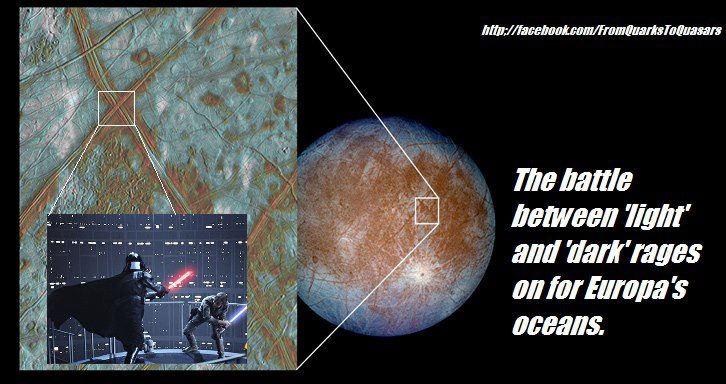

If you were to travel right now to the oceans of Europa—theorized to be found deep beneath its ice-covered surface—and go for a swim…would you find pitch darkness, or would there be a light from somewhere?
In Earth’s oceans, light from the Sun only penetrates down about 200 meters (656 feet); which makes places like the Mariana Trench (11,000 meters/36,201 feet down) very dark indeed. And that’s just in places with open water! Never mind ocean water covered with ice.
Ice absorbs quite a bit of light (an important factor in Arctic ice melt right now, as young ice absorbs less light than older ice, so losing ‘old ice’ exacerbates the problem), which means that sunlight really doesn’t have much chance of making it to the Europan seas if the ice is past a certain amount of thickness.
So, just how thick -is- the ice of Europa? Is it thin enough to allow light through?
Well, as it turns out—much like the struggles of the Jedi and Sith in “Star Wars”—there’s a battle going on in the science community between ‘light’ and.’dark’!
The ”Thin icers” argue for light, saying that the surface evidence shows that Europa has thin enough ice to let sunlight trickle through; while the “thick icers” suggest the ice must actually be many kilometers thicker (19 vs. just a few), which would make the oceans of Europa a realm of darkness.
The battle, appropriately enough, hinges on features called “chaos terrain” which may or may not be similar to icebergs on Earth. Talk about a perfect setting for the battlefield of light vs. dark!
But, there’s a wild card in all this conflict (someone call J.J. Abrams): What if Europa gets light from within?
Even in some of the most ridiculously dark places of the ocean, creatures end up making their own light: bioluminescence. In bioluminescence, the right chemicals mix together, and bam— light! Just like living glow sticks.
So, in theory, if life evolved in the seas of Europa (which would exist due to internal heating from the planet), some of it could have evolved its own light—and an adventuring robot expecting complete darkness down there could instead find a glittering sea of light.
And there’s another way to light, too: vents. Deep sea ocean vents have been found to give off light waves, albeit mostly infrared (with a tiny amount in the visible). So, potentially, if you were to find yourself surrounded by liquid hot magma down deep in Europa, it might be hot enough to provide a glow to see by (at least for the local residents).
So, which side do you fall on—light, or dark?